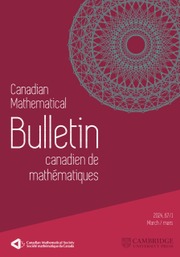No CrossRef data available.
Article contents
Product of two involutions in quaternionic special linear group
Part of:
Structure and classification of infinite or finite groups
Other groups of matrices
Basic linear algebra
Special matrices
Published online by Cambridge University Press: 08 January 2025
Abstract
An element of a group is called reversible if it is conjugate to its own inverse. Reversible elements are closely related to strongly reversible elements, which can be expressed as a product of two involutions. In this paper, we classify the reversible and strongly reversible elements in the quaternionic special linear group  $ \mathrm {SL}(n,\mathbb {H})$ and quaternionic projective linear group
$ \mathrm {SL}(n,\mathbb {H})$ and quaternionic projective linear group  $ \mathrm {PSL}(n,\mathbb {H})$. We prove that an element of
$ \mathrm {PSL}(n,\mathbb {H})$. We prove that an element of  $ \mathrm {SL}(n,\mathbb {H})$ (resp.
$ \mathrm {SL}(n,\mathbb {H})$ (resp.  $ \mathrm {PSL}(n,\mathbb {H})$) is reversible if and only if it is a product of two skew-involutions (resp. involutions).
$ \mathrm {PSL}(n,\mathbb {H})$) is reversible if and only if it is a product of two skew-involutions (resp. involutions).
Keywords
Information
- Type
- Article
- Information
- Copyright
- © The Author(s), 2025. Published by Cambridge University Press on behalf of Canadian Mathematical Society
References
Arnol’d, V. I. and Avez, A., Ergodic problems of classical mechanics. Translated from the French by A. Avez, W. A. Benjamin, Inc., New York and Amsterdam, 1968, MR0232910.Google Scholar
Baake, M.,
A brief guide to reversing and extended symmetries of dynamical systems
. In: Ergodic theory and dynamical systems in their interactions with arithmetics and combinatorics, Lecture Notes in Mathematics, 2213, pp. 117–135, MR3821715.CrossRefGoogle Scholar
Burton, D. M., Elementary number theory, 7th ed., McGraw-Hill, New York, 2011, ISBN: 978-0-07-338314-9.Google Scholar
Basmajian, A. and Maskit, B.,
Space form isometries as commutators and products of involutions
. Trans. Amer. Math. Soc. 364(2012), no. 9, 5015–5033, MR2922617.CrossRefGoogle Scholar
Baake, M. and Roberts, J. A. G.,
The structure of reversing symmetry groups
. Bull. Austral. Math. Soc. 73(2006), 445–459, MR2230652.CrossRefGoogle Scholar
Djoković, D. Ž.,
Product of two involutions
. Arch. Math. (Basel) 18(1967), 582–584, MR0219550.CrossRefGoogle Scholar
Dutta, S., Gongopadhyay, K., and Lohan, T.,
Classification and decomposition of quaternionic projective transformations
. Linear Algebra Appl. 676(2023), 66–87, MR4618023.CrossRefGoogle Scholar
Ellers, E. W.,
Products of two involutory matrices over skewfields
. Linear Algebra Appl. 26(1979), 59–63, MR0535679.CrossRefGoogle Scholar
Gongopadhyay, K.,
Algebraic characterization of the isometries of the hyperbolic 5-space
. Geom. Dedicata. 144(2010), 157–170, MR2580424.CrossRefGoogle Scholar
Gongopadhyay, K.,
Conjugacy classes in Möbius groups
. Geom. Dedicata. 151(2011), 245–258, MR2780749.CrossRefGoogle Scholar
Gongopadhyay, K., Lohan, T., and Maity, C.,
Reversibility and real adjoint orbits of linear maps
. In: Papadopoulos, A. (ed.), Essays in Geometry, dedicated to Norbert A’Campo, European Mathematical Society Press, Berlin, 2023, MR4631271.Google Scholar
Gongopadhyay, K., Lohan, T., and Maity, C.,
Product of two involutions in complex special linear group
, preprint, 2023. arXiv:2307.07967.Google Scholar
Gongopadhyay, K., Lohan, T., and Maity, C.,
Reversibility of affine transformations
. Proc. Edinb. Math. Soc. (2). 66(2023), no. 4, 1217–1228, MR4679222.CrossRefGoogle Scholar
Gongopadhyay, K. and Maity, C.,
Reality of unipotent elements in classical Lie groups.
Bull. Sci. Math. 185(2023), Article no. 103261, MR4583694.CrossRefGoogle Scholar
Gill, N. and Singh, A.,
Real and strongly real classes in
 ${SL}_n(q)$
. J. Group Theory 14(2011), no. 3, 437–459, MR2794377.CrossRefGoogle Scholar
${SL}_n(q)$
. J. Group Theory 14(2011), no. 3, 437–459, MR2794377.CrossRefGoogle Scholar
Hoffman, F. and Paige, E. C.,
Products of two involutions in the general linear group
. Indiana Univ. Math. J. 20(1970/71), 1017–1020, MR0280508.CrossRefGoogle Scholar
Joven, J. P. E. and Paras, A. T.,
Agnes, products of skew-involutions
. Electron. J. Linear Algebra 39(2023), 136–150, MR4573835.CrossRefGoogle Scholar
Lávička, R., O’Farrell, A., and Short, I.,
Reversible maps in the group of quaternionic Möbius transformations
. Math. Proc. Cambridge Philos. Soc. 143(2007), no. 1, 57–69, MR2340975.CrossRefGoogle Scholar
Lamb, J. S. W. and Roberts, J. A. G.,
Time-reversal symmetry in dynamical systems: a survey
. Phys. D. 112(1998), nos. 1–2, 1–39, MR1605826.CrossRefGoogle Scholar
O’Meara, K. C., Clark, J., Vinsonhaler, C. I., Advanced topics in linear algebra: Weaving matrix problems through the Weyr form, Oxford University Press, Oxford, 2011, MR2849857.Google Scholar
O’Farrell, A. G.,
Reversibility questions in groups arising in analysis
. In: Complex analysis and potential theory, CRM Proceedings and Lecture Notes, 55, American Mathematical Society, Providence, RI, 2012, pp. 293–300, MR2986909.CrossRefGoogle Scholar
O’Farrell, A. G. and Short, I., Reversibility in Dynamics and Group Theory, Vol. 416. London Mathematical Society Lecture Note Series, Cambridge University Press, Cambridge, 2015, MR3468569.CrossRefGoogle Scholar
Parker, J. R. and Short, I.,
Conjugacy classification of quaternionic Möbius transformations
. Comput. Methods Funct. Theory. 9(2009), no. 1, 13–25, MR2478260.CrossRefGoogle Scholar
Paras, A. T. and Salinasan, J.R.,
The product of an involution and a skew-involution
. Linear Algebra Appl. 584(2020), 431–437, MR4014740.CrossRefGoogle Scholar
Rodman, L.. Topics in quaternion linear algebra. Princeton Series in Applied Mathematics. Princeton University Press, Princeton, NJ, 2014, MR3241695.Google Scholar
Roche, A. and Vinroot, C. R.,
A factorization result for classical and similitude groups
. Canad. Math. Bull. 61(2018), no. 1, 174–190, MR3746483.CrossRefGoogle Scholar
Shapiro, H.,
The Weyr Characteristic
. Amer. Math. Monthly, 106, 1999, 919–929, MR1732500.CrossRefGoogle Scholar
Short, I.,
Reversible maps in isometry groups of spherical, Euclidean and hyperbolic space
. Math. Proc. R. Ir. Acad. 108(2008), no. 1, 33–46, MR2448811.CrossRefGoogle Scholar
Singh, A. and Thakur, M.,
Reality properties of conjugacy classes in algebraic groups
. Israel J. Math. 165(2008), 1–27, MR2403612.CrossRefGoogle Scholar
Tiep, P. H. and Zalesski, A. E.,
Real conjugacy classes in algebraic groups and finite groups of Lie type
. J. Group Theory 8(2005), no. 3, 291–315, MR2137972.CrossRefGoogle Scholar
Wonenburger, M. J.,
Transformations which are products of two involutions
. J. Math. Mech. 16(1966) 327–338, MR0206025.Google Scholar


